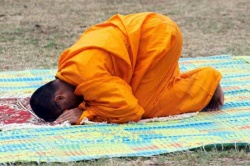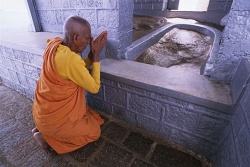Understanding Refuge
The aim of Buddhist practice is to end suffering. A refuge is a place where one goes to be free from harm, fear, and suffering. In Buddhism, refuge is a metaphor for wakefulness or presence. It is reminder of the basic orientation in Buddhist practice, namely, that suffering comes to end only through being awake and present.
Another way to think about refuge is that you become a refugee. A refugee is someone who leaves a country or homeland because life is no longer tenable there. When you take refuge, you are acknowledging that a life based on habituated patterns is no longer tenable for you. You are prepared to set out into the mystery and rely on awareness, wherever it may lead you.
Who takes refuge?
You do. The person who seeks to end suffering takes refuge.
Refuge takes expression as a simple formula that you repeat as many times as you wish, usually at least three:
- I take refuge in the Buddha.
- I take refuge in the Dharma.
- I take refuge in the Sangha.
Refuge also takes expression as a vow. In the ceremony conducted by a teacher or spiritual elder, you, the student, formally acknowledge that you are taking wakefulness (buddha) as your principal orientation in life.
Ultimately, refuge is the direct knowing in which experience arises as movement in mind and the processes of reaction and suffering no longer take place.
What do I take refuge in?
You take refuge in the Three Jewels: the Buddha, the Dharma, and the Sangha. The Three Jewels may be understood on several levels:
| Buddha | Dharma | Sangha | |
| External Resources traditionally “outer refuge” |
the teacher | the way | the guides |
| Internal Understanding traditionally “inner refuge” |
being awake | experiential |
making use of experience |
| Direct Experience traditionally “secret refuge” |
emptiness | clarity | unrestricted |

